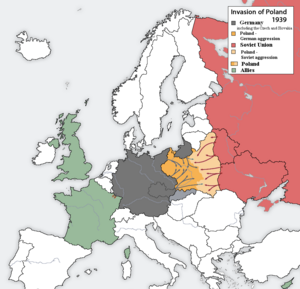ভার্সাই চুক্তি অনুসারে জার্মানির (বর্তমান পোল্যান্ড-এর) ডানজিগ বন্দরের মালিকানা দিয়ে দেয়া হয়েছিল রাষ্ট্রপুঞ্জকে [league of nations]।১৯৩৯ এর ২১ শে মার্চ হিটলার ডানজিগের মালিকানা এবং ঐ পর্যন্ত যাবার জন্য পোল্যান্ডের ভেতর দিয়ে সড়ক ও রেলপথ দাবী করেন ।পোল্যান্ড দাবী অগ্রাহ্য করায় যুদ্ধের সম্ভাবনা তৈরি হল ।
সোভিয়েত ইউনিয়নকে নিষ্ক্রিয় রাখার জন্য জার্মানি অনাক্রমণ চুক্তি [non-aggression treaty] করে ।এই চুক্তিতে গোপণে ভাগবাঁটোয়ারার খসড়াও করা হয় ।
অন্যদিকে ব্রিটেন ও ফ্রান্স পোল্যান্ডের সাথে সহায়তা চুক্তি করে ।
১লা সেপ্টেম্বর সীমান্তে একটি সাজানো আক্রমণের ছুতো ধরে হিটলার পোল্যান্ড দখলের অভিযান শুরু করল ।৩রা সেপ্টেম্বর মিত্রবাহিনী জার্মানির বিরুদ্ধে যুদ্ধ ঘোষণা করল,এবং শুরু হল দ্বিতীয় বিশ্বযুদ্ধ ।
পোলিশ বাহিনী আয়তনে যথেষ্ট বিশাল হলেও তাদের অস্ত্রশস্ত্র ও সামরিক চিন্তাভাবনা ছিল সনাতন ।প্রথম দিনই জার্মান বিমান বাহিনী বোমা ফেলে তাদের শহর ,রেল ,সেতু ,শক্তিকেন্দ্র এবং তাদের বিমান বাহিনী অচল করে দিল ।অন্যদিকে সাইলেশিয়া ,প্রুশিয়া ,মোরাভিয়া ,স্লোভাকিয়া দিয়ে জার্মান বাহিনী ঢুকে পোলিশ বাহিনীকে ছিন্নবিচ্ছিণ্ন করে দিল ।ফরাসি ও ব্রিটিশ বাহিনী সাহায্য করবার সুযোগ পেল না ।এটি পশ্চিমের বিশ্বাসভঙ্গতা হিসেবে পরিচিত ।
জার্মানির এই নতুন ধরনের যুদ্ধ পদ্ধতি blitzkrieg বা ঝটিকা যুদ্ধ নামে পরিচিত ।
১৭ই সেপ্টেম্বর গোপন সমঝোতা অনুসারে সোভিয়েত বাহিনীও আক্রমণে যোগ দিল । পরদিনই পোলিশ কর্তাব্যক্তিরা দেশ ছাড়লেন ।ওয়ারস পতন হলো ২৭শে সেপ্টেম্বর ।শেষ সেনাদল কক্ দুর্গে যুদ্ধ করে ৬ই অক্টোবর পর্যন্ত ।
পোল্যান্ড অবশ্য আনুষ্ঠানিকভাবে আত্মসমর্পণ করেনি ।অনেক পোলিশ মিত্র বাহিনীতে যোগ দেয় এবং অনেকে যুদ্ধ শেষ হওয়া পর্যন্ত গেরিলা যুদ্ধ চালিয়ে যায় ।
দ্রুত তথ্য নাৎসি বাহিনীর পোল্যান্ড আক্রমণ, তারিখ ...
| নাৎসি বাহিনীর পোল্যান্ড আক্রমণ |
|---|
| মূল যুদ্ধ: World War II |

The map shows the beginning of the Second World War in September 1939 in a wider European context. |
| তারিখ | 1 September – 6 October 1939 |
|---|
| অবস্থান | |
|---|
| ফলাফল |
Decisive Axis and Soviet victory
Beginning of World War II
- Polish territory divided between Germany, the USSR, Lithuania and Slovakia
|
|---|
|
| বিবাদমান পক্ষ |
|---|
|
 Germany Germany
 Slovakia Slovakia
 Soviet Union Soviet Union |
 Poland Poland |
| সেনাধিপতি ও নেতৃত্ব প্রদানকারী |
|---|
|
 Fedor von Bock Fedor von Bock
(Army Group North)
 Gerd von Rundstedt Gerd von Rundstedt
(Army Group South)
 Ferdinand Čatloš Ferdinand Čatloš
(Army Bernolák)
 Mikhail Kovalev Mikhail Kovalev
(Belorussian Front)
 Semyon Timoshenko Semyon Timoshenko
(Ukrainian Front) |
 Edward Rydz-Śmigły Edward Rydz-Śmigły |
| শক্তি |
|---|
|
Germany:
60 divisions,
4 brigades,
9,000 guns,[1]
2,750 tanks,
2,315 aircraft[2]
Slovakia:
3 divisions
Joined on 17 September:
Soviet Union:
33+ divisions,
11+ brigades,
4,959 guns,
4,736 tanks,
3,300 aircraft
Total:
1,500,000 Germans,[1]
466,516 Soviets,[3]
51,306 Slovaks
Grand total: 2,000,000+ |
Poland:
39 divisions (some of them were never fully mobilized and concentrated),[4]
16 brigades,[4]
4,300 guns,[4]
880 tanks,
400 aircraft[1]
Total: 950,000[Note 1] |
| হতাহত ও ক্ষয়ক্ষতি |
|---|
|
Germany:[Note 2]
16,343 killed,
3,500 missing,[11]
30,300 wounded
Slovakia:
37 killed,
11 missing,
114 wounded[12]
USSR:[Note 3]
1,475 killed or missing,
2,383 wounded |
Poland:[Note 4]
66,000 dead,
133,700 wounded,
694,000 captured |
বন্ধ
টেমপ্লেট:Campaignbox Polish September Campaign
টেমপ্লেট:WW2Theatre
Кривошеев Г. Ф., Россия и СССР в войнах XX века: потери вооруженных сил. Статистическое исследование (Krivosheev G. F., Russia and the USSR in the wars of the 20th century: losses of the Armed Forces. A Statistical Study Greenhill 1997 আইএসবিএন ১-৮৫৩৬৭-২৮০-৭) (রুশ) Переслегин. Вторая мировая: война между реальностями.- М.:Яуза, Эксмо, 2006, с.22; Р. Э. Дюпюи, Т. Н. Дюпюи. Всемирная история войн.—С-П,М: АСТ, кн.4, с.93
Internetowa encyklopedia PWN, article on 'Kampania Wrześniowa 1939'
Website of the Polish Ministry of Foreign Affairs – the Poles on the Front Lines
Wojna Obronna Polski 1939, page 851
KAMIL CYWINSKI, Waffen und Geheimwaffen des deutschen Heeres 1933-1945
"Axis Slovakia: Hitler's Slavic Wedge, 1938-1945", page 81
Various sources contradict each other so the figures quoted above should only be taken as a rough indication of the strength estimate. The most common range differences and their brackets are: German personnel 1,500,000 (official figure of the Polish Ministry of Foreign Affairs) – or 1,800,000. Polish tanks: 100–880, 100 is the number of modern tanks, 880 number includes older IWWs tanks and tankettes.[5][6] The discrepancy in German casualties can be attributed to the fact that some German statistics still listed soldiers as missing decades after the war. Today the most common and accepted numbers are: 8,082 to 16,343 KIA, 320 to 5,029 MIA, 27,280 to 34,136 WIA.[7]. For comparison, in his 1939 speech following the Polish Campaign Adolf Hitler presented these German casualty figures: 10,576 KIA, 30,222 WIA, and 3,400 MIA.[8]. According to early Allied estimates, including those of the Polish government-in-exile, the number of German KIA casualties was 90,000 and WIA casualties was 200,000[8][9]
Equipment losses are given as 832 German tanks [10] of with approximately 236[10] to 341 as irrecoverable losses and approximately 319 other armoured vehicles as irrecoverable losses (including 165 Panzer Spahwagen – of them 101 as irrecoverable losses)[10] 522–561 German planes (including 246–285 destroyed and 276 damaged), 1 German minelayer (M-85) and 1 German torpedo ship ("Tiger") Soviet official losses are estimated at 737 to 1,475 KIA or MIA (Ukrainian Front – 972, Belorussian Front – 503, and 1,859 to 2,383 WIA (Ukrainian Front – 1,741, Belorussian Front – 642). The Soviets lost approximately 150 tanks in combat of which 43 as irrecoverable losses, while hundreds more suffered technical failures.[3] Various sources contradict each other so the figures quoted above should only be taken as a rough indication of losses. The most common range brackets for casualties are: Poland: 63,000 to 66,300 KIA, 134,000 WIA.[7]. The often cited figure of 420,000 Polish prisoners of war represents only those captured by the Germans, as Soviets captured about 250,000 Polish POWs themselves, making the total number of Polish POWs about 660,000–690,000. In terms of equipment the Polish Navy lost 1 destroyer (ORP Wicher), 1 minelayer (ORP Gryf) and several support craft. Equipment loses included 132 Polish tanks and armoured cars 327 Polish planes (118 fighters))[10]
